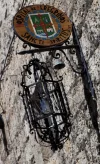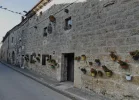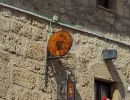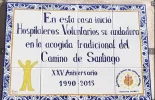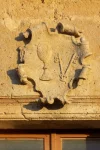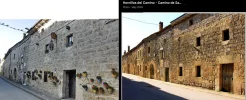Moderato´s Edit: there is a Google translate version in the next post.
I agree with
@Kathar1na 's earlier post. I lived in spain for 10 years and i noticed that the term
romeria is used to define processions and short pilgrimages, usually connected to local saints.
Whether it's connected to Rome I'm not sure, but the plant
romero, rosemary in English, is used often in religious ceremonies as an offering.
This text in Spanish may help shed some more light on the huge importance of the plant:
EL ROMERO Y SUS BENEFICIOS CURATIVOS.
Un arbusto milenario que posee muchas cualidades curativas.
Desde la época de los romanos se le adjudican incontables propiedades terapéuticas. Aprenda a utilizarlo regularmente en la cocina cotidiana.
Ya desde el origen de la palabra romero nos anticipa una rica veta poética. «Rocío de Mar» (ros marinus) le decían los romanos a este arbusto originario del mediterráneo y que aún hoy en día crece silvestre en Italia, Francia, España y Norte de África.
Al mirar este humilde arbusto que suele estar en algún rincón del jardín, difícilmente imaginamos que haya dado origen a tantas leyendas, anécdotas e historias desde los más remotos tiempos.
En Egipto se lo depositaba en las tumbas para que no se extinga la memoria de los difuntos.
Entre los griegos y luego los romanos era consagrado a Afrodita, la diosa del amor y los placeres sexuales. Por eso formaba parte de las coronas de las novias con el fin de augurar una feliz consumación del matrimonio.
Cuenta la leyenda que el romero tenía las flores blancas. Cuando la Sagrada Familia viajaba de Israel a Egipto, la Virgen María apoyó su manto celeste sobre una planta de romero: desde entonces sus flores que eran blancas cambiaron de color.
La Edad Media nos ha legado multitud de fórmulas de remedios y ungüentos. Los monjes, que apreciaban mucho sus virtudes, lo cultivaron en los conventos diseminándolo así por toda Europa. Se colocaba en los banquillos de los acusados para evitar el contagio de la «peste de las crujías».
Carlomagno decretó que se cultivará en todos los jardines del Sacro Imperio Romano Germánico, que abarcaba Italia, Francia, Alemania y regiones de otros países.
En 1598 fue introducido en Inglaterra.
Cuenta la leyenda que un ángel le dictó la receta de un agua rejuvenecedora a la reina Isabel de Hungría en el siglo XIV. Ya reumática y casi paralítica, con esta fórmula cuyo componente principal era el romero, a los 72 años recuperó su salud y conquistó al rey de Polonia que era 20 años más joven.
Tan rico en historias como en virtudes terapéuticas el romero es rescatado hoy en día como un poderoso agente
Leyendas populares de la planta de Romero
La planta de romero es muy popular por sus propiedades medicinales y su aroma. Es una de las hierbas aromáticas con más uso en la cocina, la salud y la belleza, pero el romero esconde mucho más. Según cuenta la leyenda trae buena suerte, veamos por qué.
Sus usos en la historia
Las propiedades medicinales de esta hierba aromática eran muy conocidas desde siglos pasados. Los griegos y romanos la llamaban “rocío marino” o “rocío del mar” por su presencia en las cercanías de la costa mediterránea, y tenía muchos usos. La utilizaban en sus cultos y ofrendas a los dioses; la empleaban en coronas de romero para ayudar a los estudiantes en sus exámenes mejorando su memoria (atributo medicinal característico del romero); y también perfumaban sus casas quemando romero.
En el antiguo Egipto, en cambio, la planta de romero era considerada un afrodisiaco que utilizaban en las coronas de las novias para asegurar el placer sexual en el matrimonio.
También era usada como símbolo de inmortalidad y colocaban un ramito de hojas de romero en las manos de sus difuntos para acompañarles en su viaje a la ultratumba. Está tradición se extendió en gran parte de Europa y se comenzó a depositar en los cementerios junto con el laurel y el mirto.
En la Europa de la Edad Media los monjes empezaron a cultivar planta medicinal romero en los conventos y monasterios. Luego, está tradición se extendió por toda Europa y empezó a utilizarse en gran cantidad de ungüentos y remedios gracias a los beneficios del romero para la salud.
En esa misma época, los peregrinos cristianos relajaban sus pies con las propiedades calmantes del romero planta después de largas horas de peregrinación.
La leyenda de la Virgen María
Hay varias leyendas que relacionan la planta de romero con la Virgen María, y por eso es hoy día es un símbolo de la Navidad. Se dice que la Virgen perdió su manto azul durante su huida de Egipto y cayó sobre un arbusto sin flor, el romero, que luego floreció con pequeñas florecitas azules. Otra historia cuenta que el arbusto de romero sirvió de asilo a la Virgen María ocultándola también durante su huida.
Estas leyendas han popularizado la creencia de que cuando florece tu planta de romero es porque la Virgen ha pasado cerca y la ha rozado con su manto. Por estó es una tradición popular poner en las casas en la Nochebuena para traer la buena suerte












